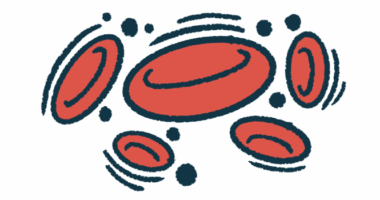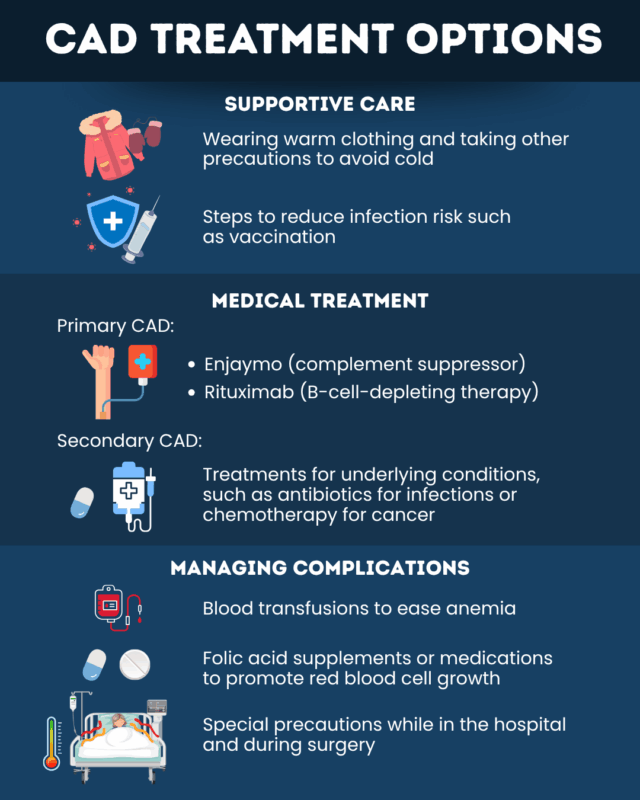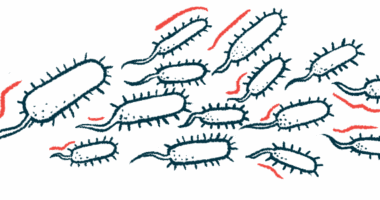
Treatment of cold agglutinin disease
Last updated Sept. 29, 2025, by Marisa Wexler, MS

Cold agglutinin disease (CAD) is a rare disease in which the body’s immune system attacks red blood cells at low temperatures. This leads to symptoms including fatigue, weakness, pain, and skin discoloration.
CAD treatment may involve lifestyle changes and medications to control symptoms and address any underlying health problems. Care for patients with CAD can help people coping with CAD maximize their quality of life and avoid serious disease complications.
When is treatment needed?
CAD is characterized by anemia (low red blood cell counts) and circulatory problems triggered by cold temperatures. Common symptoms of CAD that should prompt medical evaluation include:
- weakness and fatigue
- dizziness
- paleness
- shortness of breath
- rapid heartbeat or palpitations
- pain and discoloration of the extremities in response to cold
Receiving a diagnosis of CAD does not necessarily mean medical treatment is required. People with mild anemia and absent or tolerable symptoms may be able to control the disease using only day-to-day strategies to avoid triggers that might cause symptoms to worsen, including cold exposure.
In contrast, medications are recommended to keep the disease under control for those with noticeable symptoms of anemia, including significant fatigue, and/or circulatory problems that affect daily life.
Patients must be regularly monitored by a blood disease specialist to quickly identify changes in disease status and prompt medical treatment when necessary.
Day-to-day care and supportive strategies
A key part of disease management for people living with CAD is taking steps to avoid triggers that can worsen symptoms. The most notable trigger is cold temperatures, so cold avoidance is key, particularly in the head, face, hands, and feet. Severe infections, trauma, or surgery can also cause sudden symptom worsening, and should be avoided or managed properly to prevent complications.
Specific strategies that may be used as part of supportive care for CAD include:
- avoiding cold places where possible
- wearing warm clothing
- avoiding cold food and drinks
- wearing gloves when getting items out of a refrigerator
- using heaters as needed and minimizing the use of air conditioning
- taking steps to avoid infection, such as avoiding contact with sick people, routinely washing hands, and getting recommended vaccines
- communicating clearly with medical providers so that appropriate precautions are taken when in hospitals or clinics

Medical treatments
Medical treatments for managing CAD that is causing substantial health issues or persistent symptoms despite supportive care strategies depend on the type of CAD.
Both primary and secondary CAD types are caused by self-reactive antibodies, called cold agglutinins, that attack red blood cells at low temperatures, activating the immune complement cascade and ultimately destroying them. However, primary CAD occurs due to the abnormal, noncancerous growth of cold agglutinin-producing immune B-cells, while secondary CAD develops as a complication of an underlying health condition.
As such, treatment options for CAD differ between primary and secondary types.
Primary CAD treatment
Treatment of primary CAD mainly focuses on lowering levels of B-cells and cold agglutinins and lessening red blood cell destruction (hemolysis). It most commonly includes:
- Enjaymo (sutimlimab-jome), the only CAD-approved therapy to date in the U.S. and other parts of the world. Indicated to reduce hemolysis in adults with CAD, the medication works by blocking the complement cascade. In clinical trials, Enjaymo has also been associated with reduced anemia and fatigue, as well as better quality of life.
- Rituximab (sold as Rituxan and Mabthera, with biosimilars available), a B-cell-depleting therapy that, despite not being approved specifically for CAD, is widely accepted as a treatment option for the disease. Originally developed to treat B-cell cancers, rituximab has been consistently reported to help lessen anemia and ease symptoms in people with CAD.
Other medications that suppress the immune system, either by killing B-cells or blocking the complement cascade, have also been explored off-label to help manage CAD. These may include:
- bendamustine (sold as Treanda, among others)
- fludarabine
- eculizumab (sold as Soliris)
- ibrutinib (sold as Imbruvica)
Secondary CAD treatment
In secondary CAD, also known as cold agglutinin syndrome, cold agglutinins are a byproduct of an underlying health condition such as an infection, cancer, or another autoimmune disease. As such, secondary CAD treatment typically focuses on treating the underlying condition, which usually leads to CAD resolution.
Medications for secondary CAD may include:
- antibiotic or antiviral therapies to manage infections
- treatments for cancer, such as chemotherapy
- immunosuppressive therapies to manage autoimmune diseases
Management strategies for secondary CAD may also involve the same supportive CAD care strategies used in people with the primary form of the disease.
Managing complications
Additional supportive measures may be used in severe cases and/or to help with preventing or managing complications of CAD, such as severe anemia and a higher risk of thrombosis, when a blood clot blocks a blood vessel.
- Blood transfusions may be given to replenish lost red blood cells. Specific precautions, such as keeping the delivered blood warm, are needed when giving blood transfusions to people with CAD.
- Plasma exchange, or plasmapheresis, is a blood-cleaning procedure used in combination with medications to help treat CAD in emergencies. It is meant to help remove CAD-driving antibodies from circulation.
- Intravenous immunoglobulin delivers specific antibodies purified from healthy people. Used sometimes in very severe CAD cases, it is thought to potentially help by neutralizing self-reactive antibodies in the bloodstream and blocking their production. It may also help reduce the risk of infection in people who aren’t making enough infection-fighting antibodies due to immunosuppressive treatment.
- Supplements of folic acid, a nutrient needed for red blood cell growth, may be used.
- Erythropoietins (sold as Epogen/Procrit, among others) are medications that stimulate the growth of new red blood cells. They may be given to help manage anemia, especially in people whose disease isn’t responding well to first-line CAD therapies. However, due to an increased risk of life-threatening reactions, it’s recommended these treatments be used sparingly.
- Preventive treatments to reduce the risk of thrombosis may be used in some cases, especially those with severe uncontrolled disease or with other risk factors for blood clots.
In addition, special precautions during surgery, including ensuring patients stay warm throughout procedures, may help prevent cold-induced hemolysis in people with CAD.
It is also important to regularly follow patients to track disease activity and response to treatments, including blood tests for monitoring anemia in CAD.
Certain treatments used for related hemolysis-inducing autoimmune diseases are not effective in CAD and should be avoided. These include corticosteroids and splenectomy (surgical removal of the spleen).
Cold Agglutinin Disease News is strictly a news and information website about the disease. It does not provide medical advice, diagnosis, or treatment. This content is not intended to be a substitute for professional medical advice, diagnosis, or treatment. Always seek the advice of your physician or other qualified health provider with any questions you may have regarding a medical condition. Never disregard professional medical advice or delay in seeking it because of something you have read on this website.
Recent Posts
- Oral therapy iptacopan eases anemia in CAD patients: Small trial
- When living with CAD, even a short trip can be a nightmare
- Real-world study confirms long-term safety of Enjaymo for CAD
- After months of fatigue, feeling better is what I want for Christmas
- Man’s case shows bacterial lung infection can ‘provoke’ clots, CAD
- Living with cold agglutinin disease involves cruel curveballs
- Gastric lymphoma found to be hidden cause of refractory CAD
- New CAD treatments, like reading progress, prove growth is possible
- ANX1502 proof-of-concept trial to wrap up next year, Annexon says
- What if Sadie Hawkins Day made me the doctor?


